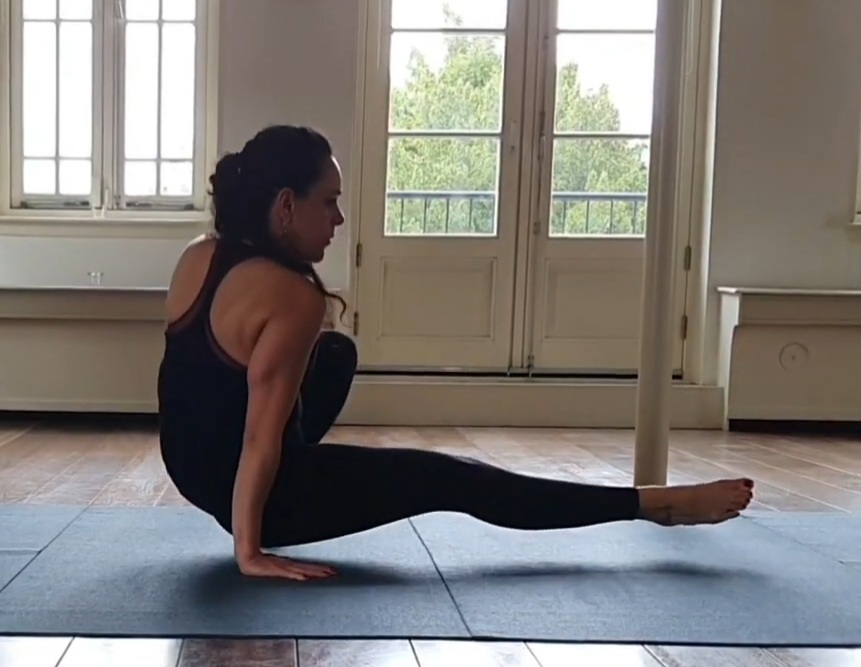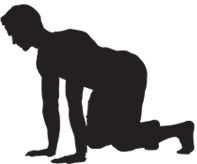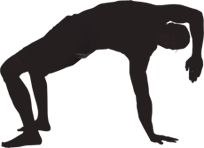
THE SIX COMPONENTS
Animal Flow includes a range of movements and combinations that are grouped into categories we call the “Six Components.” Each Component is designed to elicit specific results. The Six Components can be mixed and matched in many ways, allowing you to incorporate one, some, or all of them in your workouts.
These include:

WRIST MOBILIZATIONS
Wrist mobilizations are simple, yet effective movements used to prepare the hands and wrists for the challenges of Animal Flow. Healthy wrists are so important to the success of both novice and experienced flow-ists, that it’s the first of six components that make up the AF system.

ACTIVATIONS
Our activations are a way of “waking up” the body and encouraging it to communicate with itself. We also see the activations as a way to bring conscious awareness to your body and its interaction with the ground. The AF practice uses two activation positions, Beast and Crab, which are foundational forms in the overall program.

FORM SPECIFIC STRETCHES
The goal of the FSSs is to encourage a combination of flexibility and stability (i.e. mobility) throughout the entire body, building “strength through motion.” Each FSS begins in one of our animal base positions and moves through various end ranges of motion. These movements may be used as conditioning tools or integrated into Flows.

TRAVELING FORMS
Traveling forms are our animal locomotive movements. They represent the way we mimic animals to improve the function of the “human animal.” The basic traveling forms are known as the ABCs of animal movements: Ape, Beast, and Crab, along with their variations.

SWITCHES & TRANSITIONS
The S&Ts make up the bulk of the “flow” in the AF practice. These are dynamic movements that can be linked together to form endless combinations or can stand alone as a powerful exercise or drill. The four base S&T categories are Underswitch, Side Kickthrough, Scorpion and Front Kickthrough.

FLOWS
Flows are predesigned sequences where movements are linked together to create a continuous series of motion. Learning a Flow for the first time can be a workout in itself, as we recommend practicing each movement before putting them together into the Flow. Once you’ve learned a Flow, you can decide how you would like to use it as your complete workout or integrate it into your regular workout style. How you make the most of your Flow practice is truly up to you.
THE SCIENCE BEHIND ANIMAL FLOW
Quadrupedal movement training (QMT) is a form of bodyweight training incorporating animal poses, transitions, and crawling patterns to reportedly improve fitness. This type of training may improve multiple facets of fitness, unfortunately, little evidence exists to support commercial claims and guide practitioners in the best use of QMT. Therefore, the purpose of this study was to assess the impact of a commercially available QMT program on functional movement, dynamic balance, range of motion, and upper body strength and endurance.
Forty-two active college-age (19.76 6 2.10 years) subjects (males 5 19, females 5 23) were randomly assigned to a QMT (n 5 21) or control (CON) (n 5 21) group for 8 weeks. Quadrupedal movement training consisted of 60-minute classes performed 23·wk21 in addition to regular physical activity. Active range of motion, Functional Movement Screen (FMS), Y-Balance Test (YBT), handgrip strength, and push-up endurance were assessed before and after the intervention. The QMT group showed significantly greater improvements than the CON group in FMS composite score (1.6261.53 vs. 0.3361.15, p50.004) and FMS advanced movements (0.8160.87 vs. 0.0160.71, p50.002) and fundamental stability (0.57 6 0.75 vs. 0.05 6 0.50, p 5 0.011), along with hip flexion, hip lateral rotation, and shoulder extension (p , 0.05). No significant differences between groups were observed for dynamic balance or upper body strength and endurance.
Our results indicate that QMT can improve FMS scores and various active joint ranges of motion. Quadrupedal movement training is a viable alternative form of training to improve whole-body stabilization and flexibility.
Full article citation:
Buxton JD, Prins PJ, Miller MG, Moreno A, Welton GL, Atwell AD, Talampas TR, Elsey GE. The Effects of a Novel Quadrupedal Movement Training Program on Functional Movement, Range of Motion, Muscular Strength, and Endurance. J Strength Cond Res. 2020 Oct 5. doi: 10.1519/JSC.0000000000003818. Epub ahead of print. PMID: 33021583.
The Science Behind Animal Flow – Animal Flow
Credit: www.animalflow.com
